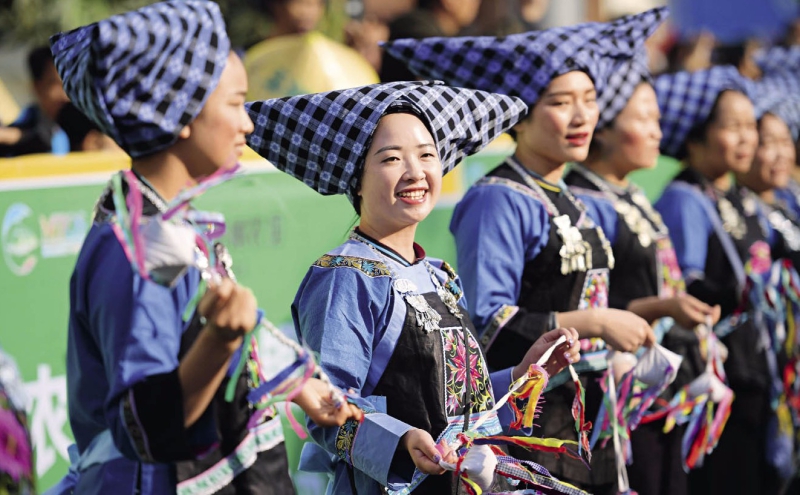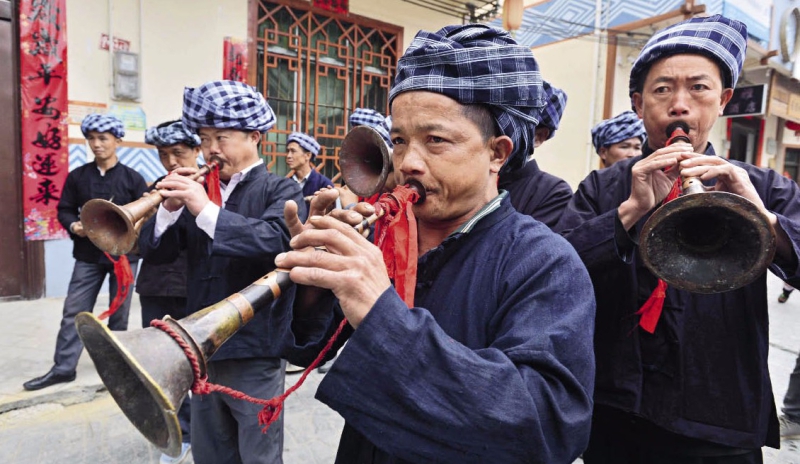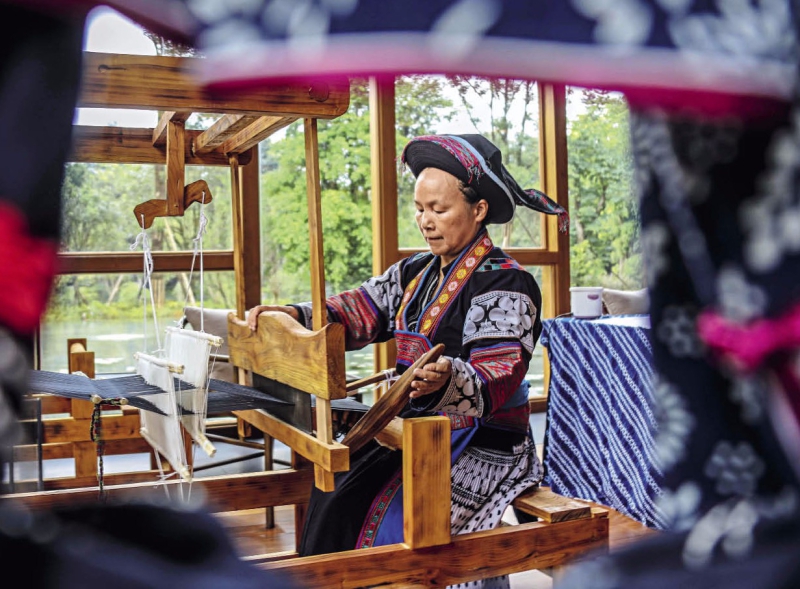
The Bouyei people dance in Wangmo County, Qianxinan Bouyei and Miao Autonomous Prefecture, Guizhou Province on April 18, 2018.
The traditional dress styles of the Bouyei people vary in their characteristics in different areas. Generally speaking, Bouyei men and women like to wear blue, green, black, and white. Young and middle-aged men usually wear turbans in blue, black or white colors. A short breasted shirt or a long version with a right-hand side button is one simple style. The color of the long shirt is mainly blue, black or white. For the lower body, trousers are a straight, large crotch style. Bouyei people traditionally wear leather or cloth shoes.
There are also differences in the costumes of Bouyei women in different regions. Women usually wear short tops with big skirts or long pants. The lapels, cuffs, and trouser legs are inlaid with lace. Bouyei women also wear a turquoise, white or plaid headsarves on their heads, along with silver bracelets, earrings, collars, and other accessories. They often wear pointed embroidered shoes. The overall color of Bouyei costumes is simple and dignified. In some areas, women’s tops are short dresses with large lapels, worn with full pleated skirts. Neckline, shoulders, and sleeves are inlaid with lace. Most of the skirt materials are batik cloth with a white background and blue flowers. A black belt with lace is often tied around the waist. Some elderly Bouyei women still keep the traditional dress habits, wearing blue cloth wrapped around their heads, short blue loose fitting collarless blouses, along with embroidered lace and piping at the seams and lower corners. Most of these women wear blue and black pleated skirts, some with blue cloth or embroidered aprons, and embroidered footwear.

A group of Bouyei people play the suona horn in Xintun Town, Qianxinan Bouyei and Miao Autonomous Prefecture, Guizhou Province on April 16, 2018.
Bouyei costumes also show the ethnic group’s unique customs. When young men and women express their love for each other, girls often use self-made clothes, handkerchiefs, or shoes as keepsakes. The unmarried girls all have braided hair, and still live in their parents’ home for some time after the wedding. On a selected day between August and September of the year after they have gotten married and April of the following year, the bridegroom’s family send two women to untie the bride’s braid, replacing it with a hat made of a bamboo shoot shell and green cloth, after which she lives with her husband’s family. This change of dress marks the official beginning of a woman’s married life, a tradition unique to the Bouyei people.
Bouyei clothing can be divided into daily wear and festive costumes. The Bouyei people wear costumes during the grand festivals such as the traditional New Year celebrations, and the cultural “Double Third” festival. The costumes are more refined, and the decoration is complex and exquisite. From head to toe, the costumes include headscarves, tops, long shirts, chest coverings, pants, skirts, waist belts, floral shoes and all kinds of jewelry. Daily life clothes are much simpler, involving just headscarves, tops and pants, with the tops having no embroidery or lace embellishment.
After a long history of development, the Bouyei have developed a unique costume culture. The women inherit the handicraft of traditional dress making, from spinning to weaving, from dyeing to tailoring, and finally to ready-made clothes, all of which are handmade.
Bouyei clothing fabric is mostly woven and dyed by themselves. Fabric can be dyed in five colors. They usually use purple grass to cook and dye purple, blue indigo to stain blue and cyan, blue indigo and wild grass to dye black, and use tree bark or Calligonum to boil and dye red brown. Dyed fabrics include more than 200 kinds of patterns, mainly lattice, stripe, plum blossom, and fish bone. The choice of this kind of natural dye and interesting patterns fully reflect the simple and enthusiastic character of the Bouyei.

Wei Qizhen, a Bouyei woman from Shitouzhai, Zhenning Bouyei and Miao Autonomous County, Anshun City, Guizhou Province, shows the batik and weaving “intangible cultural heritage” skills of the Bouyei people in Huangguoshu Waterfall Scenic Area on September 8, 2019.
In the dyeing process, batiks and tie dyeing are common. For the batiks, Bouyei women can draw patterns on cloth directly with a wax knife, and then go through several processes, such as waxing, dyeing, dewaxing and cleaning, transforming plain colored cloth into bright colored fabric art. Tie dyeing is also a common and ancient dyeing process. When tie dyeing, the white cloth is immersed into the dye, which does not reach the parts of cloth that have been tied. These parts therefore retain their original color, and form the strongly contrasted pattern. Tie dyeing and batiks are equally popular in the Bouyei clothing culture.
To make a complete costume suit, Bouyei women will make use of various craft techniques such as batik, tie dyeing, stitching, and other embroidery needle work. Stitching is a very common embroidery technique for making decorations on parts of collars, cuffs, shoulders, and skirts. Bouyei people like to decorate clothes with bright colors. The standard decoration is to embroider bright patterns on parts like sleeves, lapels, and aprons. Small items, such as handkerchiefs and pouches, also are decorated with colorful patterns. The patterns of Bouyei costumes are often found in their daily lives, including osmanthus, lotus, plum blossom, rice, magpie, butterfly, cattle, and fish. These patterns symbolize the worship of nature and the prosperity of the people. In addition, there are some abstract patterns based on geometric figures, which are also commonly used by Bouyei women in garment making.
The costume culture of the Bouyei has distinct characteristics and advocates a primitive and simple aesthetic style. The costume making technology is the crystallization of this ethnic group’s ancient culture, as well as an important part of the Chinese national costume culture.
_______________
GUO ZHIDONG is a researcher of traditional culture at the No. 93 Courtyard Museum.